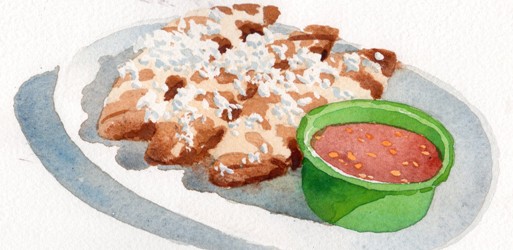Veracruz - Molotes a la Veracruzana

While the “molote” may not be one of Mexican gastronomy’s most famous “antojitos” and is nothing like as well known as tacos, enchiladas and tostadas for instance, different versions of it are found throughout the country, most particularly in Oaxaca, Puebla, San Luis Potosí and Veracruz where it is a great favourite of the street and market cooks. In some ways, it can be likened to an “empanada” or a turnover, since it consists of dough wrapped around a stuffing – chicken, chorizo, beans or minced beef for example – but I think the most appropriate description is a “croquette”.

Molotes a la Veracruzana © Philip Hood
Plump, torpedo-shaped and decidedly carbohydrate rich, the molote’s main characteristic is its pastry, which is more often than not a mixture of pre-Hispanic masa harina or corn flour and post-Conquest wheat flour, often with the addition, depending on the region and the cook, of mashed potatoes or, in the case of Veracruz, mashed cooked plantain or “plátano macho”. The plantain, which is very popular in the cuisine of the area and was introduced by the African slaves, gives the Veracruzano molote a hint of honeyed richness, and once fried, the pastry becomes golden and wonderfully crisp on the outside, while the inner layer remains soft and doughy. The molote is garnished with a bright, perky salsa like Salsa Verde and Salsa Mexicana, or gutsy, savoury cooked sauce like tomato and chipotle chilli; a generous drizzle of sour cream and a handful of fresh or aged cheese finish the dish off.
In my recipe (see link at the end of this article), I am stuffing the molotes with the black beans which are so customary in the area and flavouring them with the very “Jarocho” chipotle chilli; the combination of the faintly sweet pastry, the smoky, spicy filling, the fried plátano macho and the bright zesty salsa works wonderfully well.

Plump, torpedo-shaped and decidedly carbohydrate rich, the molote’s main characteristic is its pastry, which is more often than not a mixture of pre-Hispanic masa harina or corn flour and post-Conquest wheat flour, often with the addition, depending on the region and the cook, of mashed potatoes or, in the case of Veracruz, mashed cooked plantain or “plátano macho”. The plantain, which is very popular in the cuisine of the area and was introduced by the African slaves, gives the Veracruzano molote a hint of honeyed richness, and once fried, the pastry becomes golden and wonderfully crisp on the outside, while the inner layer remains soft and doughy. The molote is garnished with a bright, perky salsa like Salsa Verde and Salsa Mexicana, or gutsy, savoury cooked sauce like tomato and chipotle chilli; a generous drizzle of sour cream and a handful of fresh or aged cheese finish the dish off.
In my recipe (see link at the end of this article), I am stuffing the molotes with the black beans which are so customary in the area and flavouring them with the very “Jarocho” chipotle chilli; the combination of the faintly sweet pastry, the smoky, spicy filling, the fried plátano macho and the bright zesty salsa works wonderfully well.
Chilli and Chocolate Stars of the Mexican Cocina by Isabel Hood is available from Amazon.co.uk | Just The Two of Us Entertaining Each Other by Isabel Hood is available from Amazon.com and Amazon.co.uk |
You Should Also Read:
Mexico's Regional Gastronomy
Mexico's Regional Gastronomies - Veracruz
Veracruz - Molotes a la Veracruzana Recipe

Related Articles
Editor's Picks Articles
Top Ten Articles
Previous Features
Site Map
Content copyright © 2023 by Isabel Hood. All rights reserved.
This content was written by Isabel Hood. If you wish to use this content in any manner, you need written permission. Contact Mickey Marquez for details.


